How AI Transforms Bug Tracking and Resolution

Sorry, there were no results found for “”
Sorry, there were no results found for “”
Sorry, there were no results found for “”

You probably know the sinking feeling: a customer reports a bug, the sprint is stalled, and context has vanished into Slack threads. If you’re juggling bug intake, prioritization, and cross-team escalation without a central system, you’re not alone.
This is exactly why about 21% of developers now lean on AI to smooth debugging workflows. Smart bug-tracking automation is quickly evolving from novelty into necessity.
In this post, we’ll show you how smart AI-backed bug tracking helps you intake bugs faster, prioritize what matters, streamline triage, and power better collaboration.
The best part? It’s all backed by real-world examples and data you can lean on.
AI for bug tracking and resolution brings machine learning and natural language processing to the heart of bug handling—from the moment they’re logged to the moment they’re fixed and used as learning tools.
Think of it as a digital assistant that can:
By embedding AI into a unified workspace—where bug reports, engineering notes, customer feedback, and strategy all coexist—teams get smarter, quicker, and more aligned without adding extra noise or manual steps.
📮ClickUp Insight: 33% of our respondents point to skill development as one of the AI use cases they’re most interested in. For example, non-technical workers may want to learn to build code snippets for a web page using an AI tool.
In such cases, the more context the AI has about your work, the better its responses will be. As the everything app for work, ClickUp’s AI excels at this. It knows what project you are working on and can recommend specific steps or even perform tasks like creating code snippets easily.
Even today, most teams still wrestle with bug tracking that drags out delivery. Here are the usual suspects:
The good news is that AI can help you with most—if not all—of it!
Imagine sleeping in your bed, snug and safe, knowing that your building is protected by a night guard who’s always on.
AI brings that level of vigilance to your bug-tracking workflow. It’s always scanning, analyzing, and filtering code to catch unwelcome intruders and even offering solutions—yes, without you having to nudge it.
Here’s what’s changing:
To summarize how bug tracking is evolving based on the above examples, here’s a side-by-side comparison between traditional and AI-powered methods:
| Process | Traditional approach | AI-powered approach |
| Detection & testing | Manual test writing, reactive debugging post-release | Proactive detection with ML-based prioritization and auto-generated test cases |
| Triage & classification | Developers or support teams manually tag, prioritize, and assign each issue | NLP-driven categorization, severity tagging, and automated assignments (e.g., TRR) |
| Root-Cause analysis | Time-consuming manual code reviews and log tracing, often siloed | Clustering and anomaly detection highlight root causes quickly, even across services |
| Fixing | Engineers patch manually—often replicating past fixes one by one | Auto-generated or suggested patches based on learned patterns (e.g., Getafix) |
| Turnaround | Slow, error-prone, and inconsistent | Faster, consistent, and increasingly accurate as AI learns from existing data and gets smarter |
Far from replacing your developers, AI ensures that you get the best outcomes from their work.
It also helps developers move from firefighting to building—a better use of their valuable time and carefully-honed skills.
📚 Also Read: How to Use AI to Automate Tasks
🧠 Fun Fact: Only 2.5% of the companies surveyed by Techreviewer hadn’t adopted AI in software development in 2025!
Need more convincing before you let AI parse your code?
Here’s why smart teams have moved on from experimenting with AI to adopting it into the entire software development life cycle (SDLC).
📌 Why it matters for your development teams: When AI takes on repetitive testing and triage tasks, your teams get back time, clarity, and speed…without compromising quality.
Curious how you can achieve the same outcomes?
Let’s give you the right tools for the job!
To embed AI smartly into your bug-tracking and resolution workflows, consider these top-rated bug tracking software tools on the market right now:
As the everything app for work, ClickUp supports software teams with a unified workspace that merges every stage of the resolution lifecycle. Instead of juggling bug intake in Zendesk, triage in Slack, and fixes in GitHub, ClickUp brings it all together.
As a result, your bug-tracking and issue resolution workflow becomes more intuitive and transparent—powered by the world’s most complete and contextual work AI, ClickUp Brain.

Here’s a glimpse of how ClickUp makes the bug tracking and resolution process faster and smarter:

Together, these powerful features create a closed loop where intake, triage, execution, documentation, and analysis happen seamlessly in one place. It saves teams like yours hours per sprint and ensures nothing falls through the cracks.
💡 Pro Tip: Want to save even more time fixing bugs with AI? Dictate bug reports instantly via Talk to Text using ClickUp Brain MAX, your desktop AI Super App. Simply speak your issue and fail steps get transcribed and seamlessly added to a ticket. No typing, fewer errors.
Plus, Brain MAX’s unified Enterprise Search scans ClickUp Tasks/Docs, GitHub, Slack, Drive, and more—instantly pulling relevant logs, PRs, or past fixes right into the bug triage view.
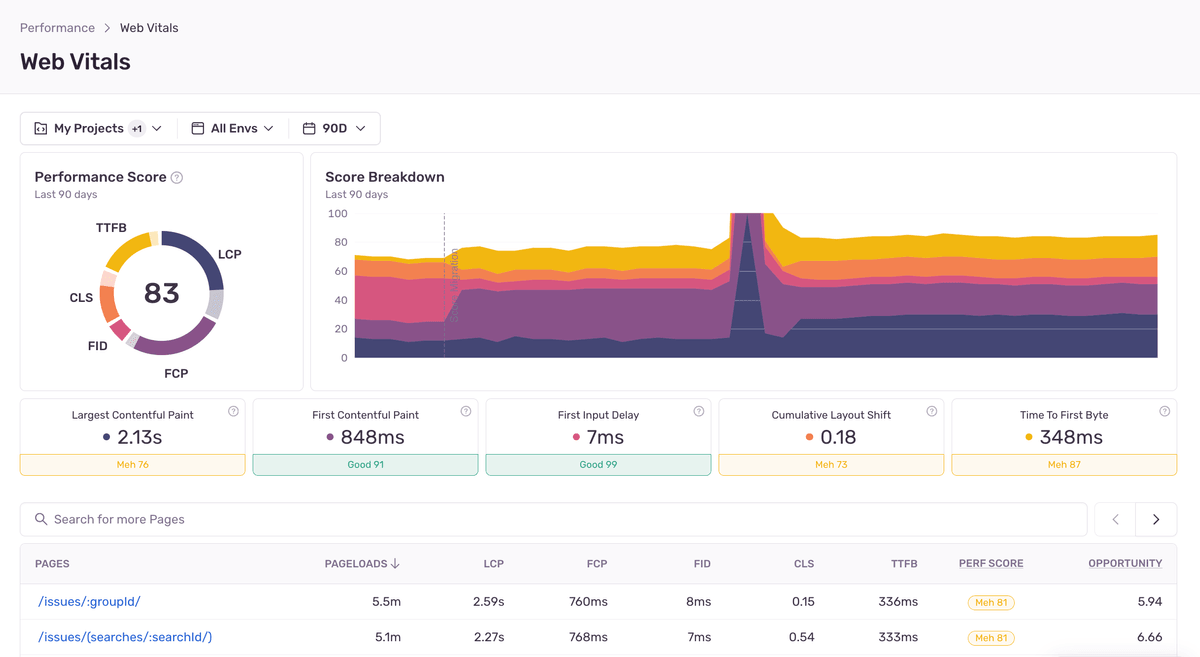
Sentry’s application monitoring platform is designed for real-time bug detection in production environments. Its AI-driven issue classification automatically groups similar errors, reducing noise and giving developers clear visibility into impact.
Sentry supports languages like Python, JavaScript, Java, Go, and more, and integrates directly into CI/CD pipelines. With performance monitoring, teams can identify slow transactions, memory leaks, or regressions before customers are hit.
Where Sentry stands apart is production-level monitoring: instead of manually combing through logs, you get an automated error feed, user context, and stack trace analysis right inside the dashboard.
For support managers, this means faster escalation of critical P0 bugs. For product leaders, it delivers trustworthy data to prioritize fixes by user or revenue impact.
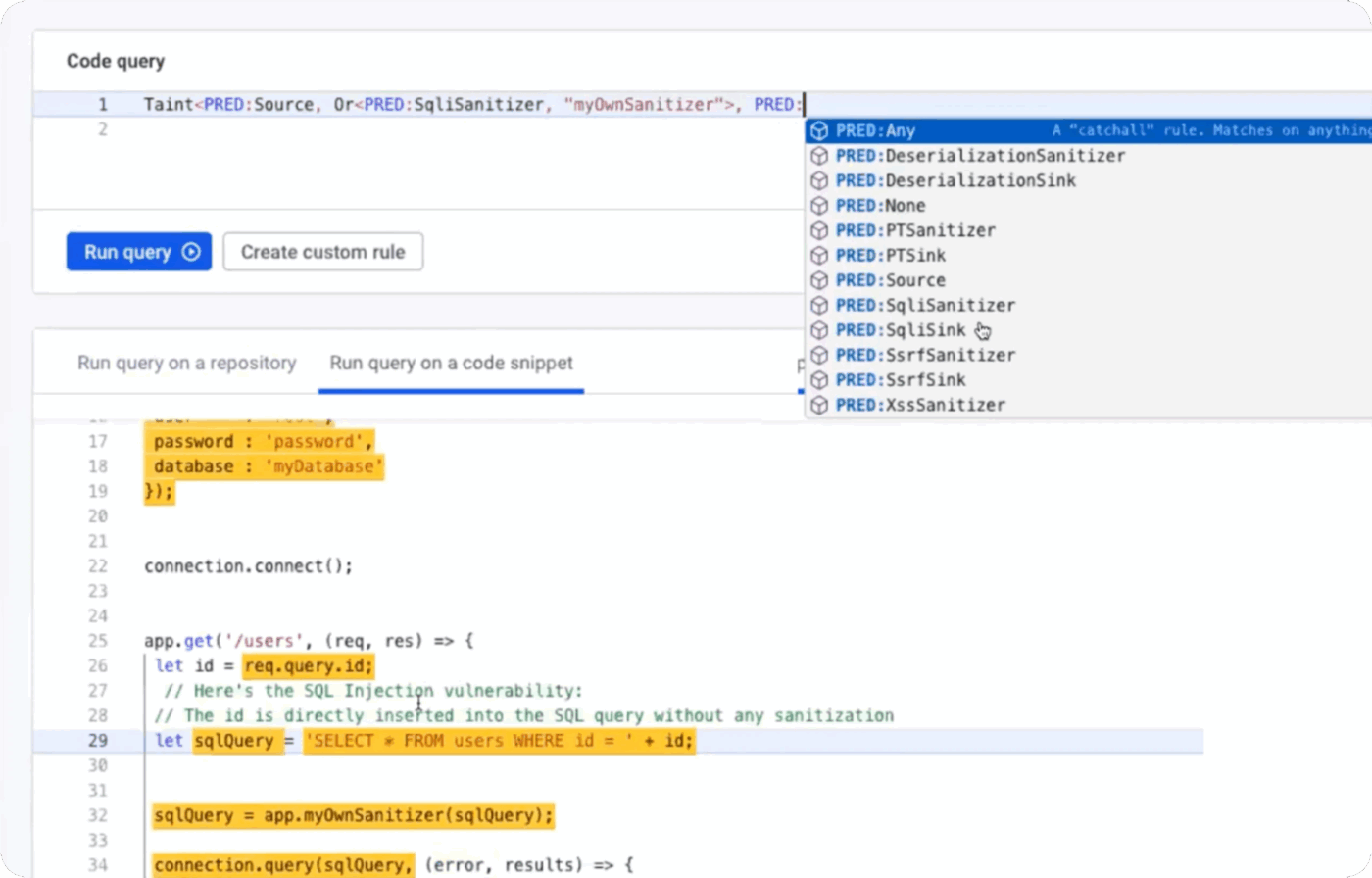
DeepCode, now part of Snyk Code, applies AI to static application security testing (SAST) and bug detection. Using a machine-learning engine trained on millions of repositories, it scans your codebase in real time to surface bugs and vulnerabilities as you type.
Unlike traditional linters that flag everything, DeepCode prioritizes issues by severity and exploitability, helping engineers focus on high-impact problems first. The tool also suggests auto-fixes—often offering one-click remediation for common bugs or vulnerabilities.
It integrates into IDEs (VS Code, IntelliJ), GitHub, GitLab, and Bitbucket, so feedback comes right where developers work. But DeepCode’s sweet spot is really for engineering teams balancing speed with safety: it reduces manual code review overhead and improves security posture while preventing bug creep. For organizations that are scaling fast, it ensures that new features ship without introducing hidden time bombs.
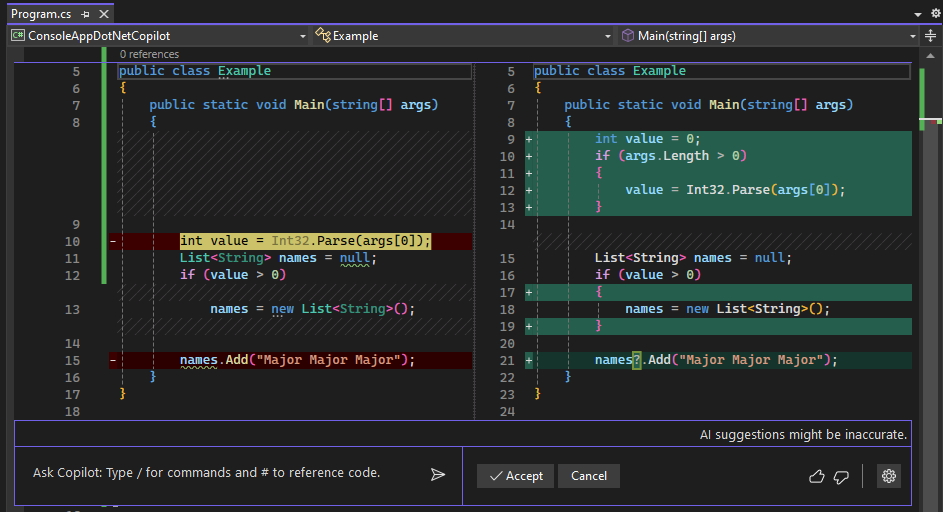
Synonymous with AI coding assistants, GitHub Copilot is best known for code autocompletion, though it’s also helpful in bug fixing. Copilot Autofix automatically suggests fixes for common vulnerabilities and regression errors—resolving up to 90% of alerts in some categories.
For developers, this means debugging happens in the same place as coding, with context pulled from surrounding files, libraries, and dependencies. Copilot integrates directly with VS Code, JetBrains IDEs, and GitHub pull requests.
It can auto-suggest patches that engineers validate instead of writing fixes from scratch. This results in shorter resolution cycles and fewer post-release headaches.

Bugasura is a modern, lightweight issue tracker built for speed and simplicity. It’s designed for distributed product and QA teams to use AI to streamline bug creation, auto-assign owners, and prioritize issues by severity.
Teams like its contextual bug reporting: you can capture issues visually via screenshots or video, annotate them, and submit with environment data attached. This reduces the typical back-and-forth between QA, support, and engineering.
Bugasura integrates with Slack, GitHub, Jira, and project management tools, ensuring updates sync across workflows. Bugasura makes it easier to collect structured, reproducible bug reports without missing details. It also ensures your backlog reflects both customer pain points and engineering needs.
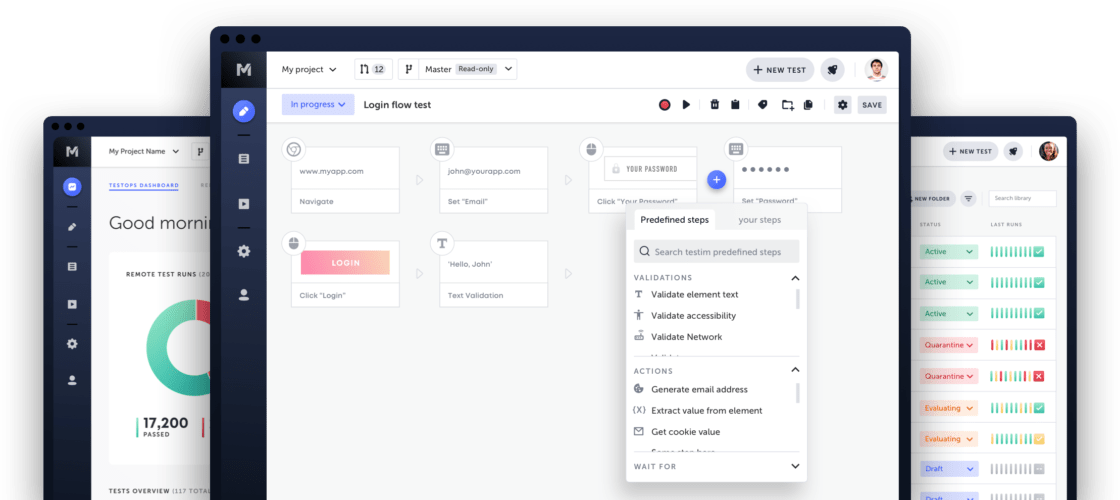
Testim.io focuses on AI-driven test automation with direct ties to bug tracking. Its biggest differentiator is self-healing tests: when UI elements change (like a button’s position or ID), Testim automatically updates locators instead of breaking. This reduces false positives and the tedious maintenance that plagues QA.
AI also generates test cases based on user flows, executes them across browsers/devices, and logs bugs automatically with screenshots and environment context. For practitioners, it means repetitive QA cycles take hours, not days, and critical regressions surface before release. For leaders, it provides confidence in shipping faster without sacrificing stability.
The bottom line? Testim isn’t just about testing—it closes the loop by linking failures directly to bug tickets, giving your dev and QA teams a smoother handoff.
Unsure which AI bug-tracking tool is right for you? We’ve listed some decision criteria here to make the process simpler:
| Tool | Best for | Key features | Pricing* |
| ClickUp | Best for mid-to-large product & support teams (Directors, QA Managers, Technical Support). Ideal when teams want a single workspace for intake → triage → execution → retros. | • AI Agents for bug summarization & auto-assignment • Intake forms + automatic duplicate detection • AI-drafted docs, release notes, and wikis via ClickUp Brain • Dashboards to monitor bug lifecycle & retros | Free plan available; Enterprise: Custom pricing |
| Sentry | Best for engineering teams at startups to enterprises needing real-time error monitoring in production. | • AI-assisted error grouping & classification • Performance monitoring & slow query detection • User impact & stack trace context • Alerts integrated into CI/CD pipelines | Free tier available; Paid plans start at $29/month; Enterprise: Custom pricing |
| DeepCode AI (Snyk Code) | Best for developer teams and security-minded orgs who need fast bug & vulnerability detection in codebases. | • AI-powered static analysis (SAST) • Auto-fix suggestions with inline remediation • IDE & repo integrations (GitHub, GitLab, Bitbucket) • Prioritization by bug severity/exploitability | Free tier available; Paid plans start at $25/month; Enterprise: Custom pricing |
| GitHub Copilot | Best for software engineering teams (small to enterprise). Ideal for devs needing inline AI bug fixes & code suggestions. | • AI code completion in IDEs • Autofix resolves ~90% of common alerts • Context-aware suggestions from repo + libraries • PR integration with GitHub workflows | Paid plans start at $10/month per user; Enterprise: Custom pricing |
| Bugasura | Best for smaller QA & support teams who want visual, lightweight bug tracking with AI auto-assignment. | • Visual bug reporting with screenshots & annotations • AI-driven auto-assignment & prioritization • Workflow integrations (Slack, GitHub, Jira) • Simple backlog management for agile teams | Free plan (up to 5 users; Paid plans start at $5/user/month; Enterprise: Custom pricing |
| Testim.io | Best for QA teams at mid-sized to enterprise orgs, focusing on automated regression testing & bug detection. | • AI-generated test cases • Self-healing locators to reduce test flakiness • Automatic defect logging with environment context • CI/CD and Jira/GitHub integrations | Free trial available; Custom pricing |
*Please check the tool website for the latest pricing
📚 Also Read: Best Modern QA Testing Tools
Want a pragmatic AI-powered workflow you can drop into your engineering org? We’ve got you covered with a step-by-step guide and pro tips on how ClickUp makes every step 10x easier to implement.
Bug reports are only as useful as the context they come with. If your intake process is messy—reports scattered across Slack or vague “it’s broken” notes in Jira—you’re starting at a disadvantage.
Strong intake means two things: structure and clarity.
Increasingly, AI helps here by asking clarifying questions, comparing a new report against known issues, and suggesting a severity level so teams don’t spend hours debating P0 versus P2.
🦄 How ClickUp helps:
With ClickUp Forms, you can standardize bug submissions right from the start. They help you capture structured bug data and pipe it straight into a dedicated List in the form of individual Tasks.
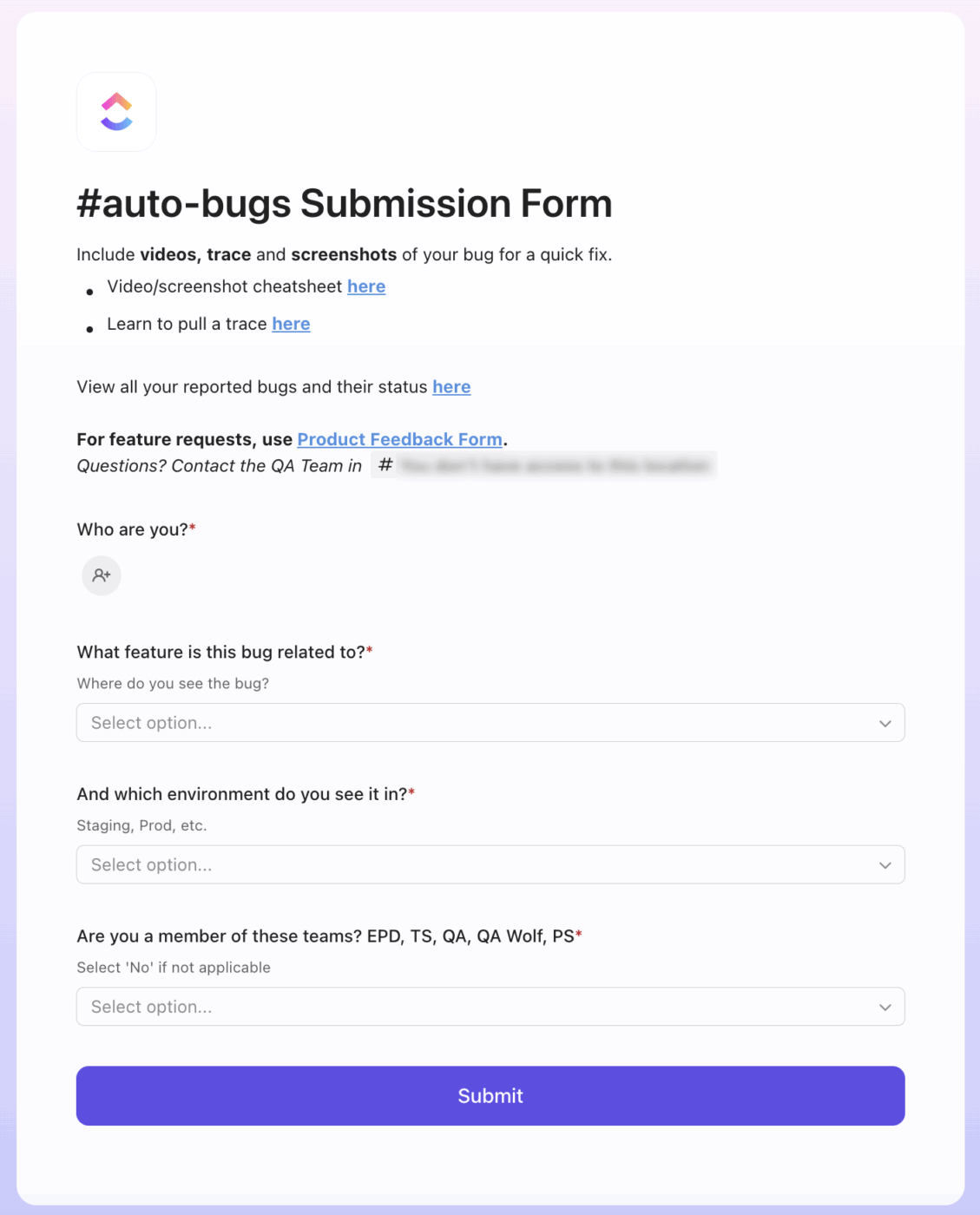
You can add Custom Fields to each Task, including the Bug Category, Priority, Affected Environment, Notes, and even Assignees responsible for resolving it. Fill them in manually or have AI Fields auto-categorize and auto-prioritize them based on set instructions.
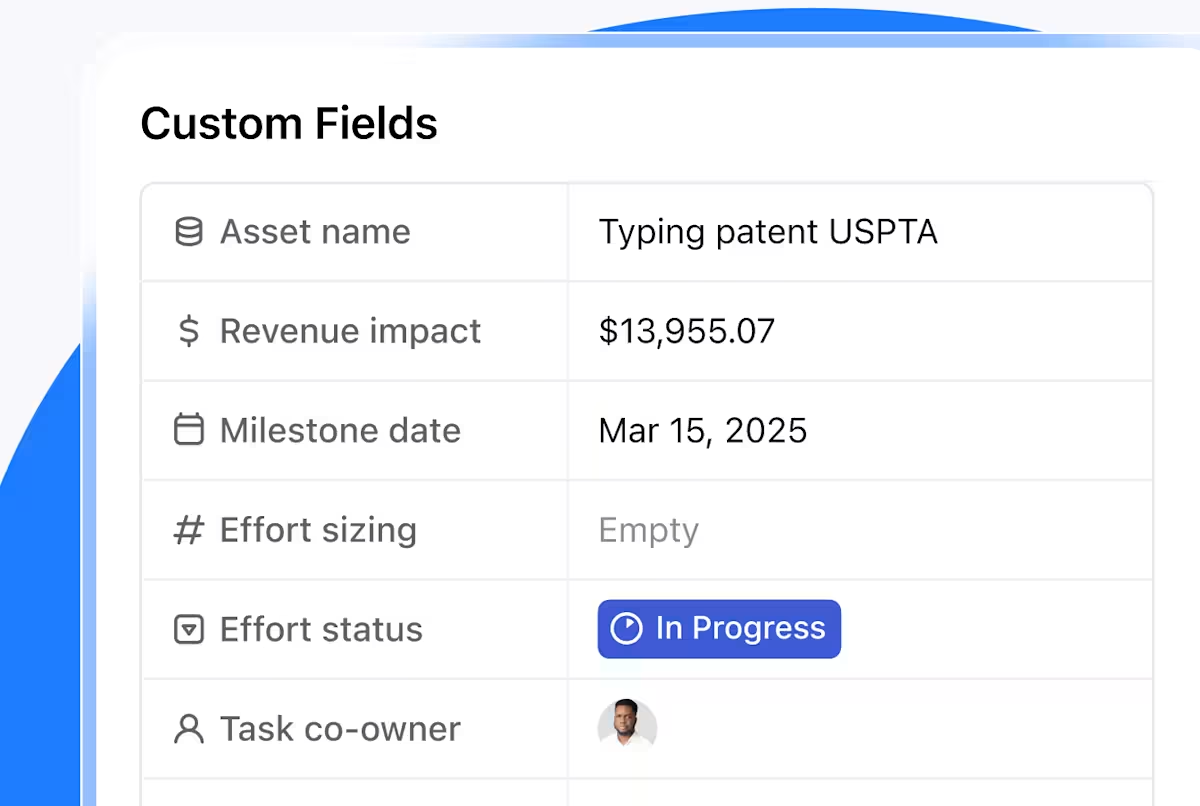
ClickUp Brain automatically summarizes long or repetitive reports and flags duplicates so engineers don’t waste cycles chasing the same problem twice.

And if a bug report is missing key details, ClickUp’s Autopilot Agents can do a quick review and prompt the reporter for more information before it even lands in your backlog. Lastly, ClickUp Automations can route P0/P1 to the right on-call queue and set SLA timers without you lifting a finger.
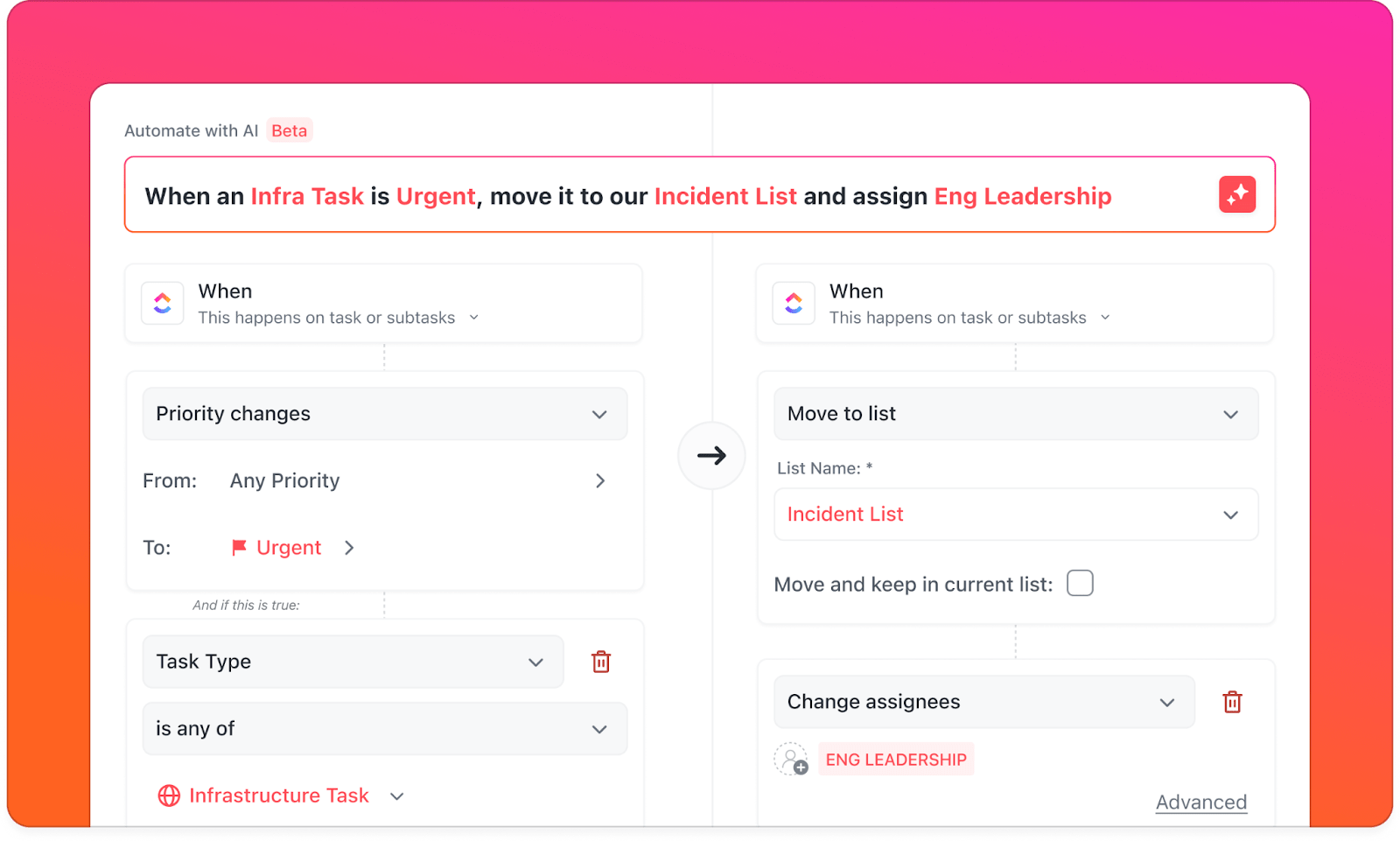
Here’s where most teams stumble. Bugs often get prioritized by who shouts the loudest. You may have an exec ping you in Slack or a customer escalation at the risk of descending into a one-star review.
The smarter approach is to weigh impact against effort:
AI can crunch those variables at scale and even recommend an owner based on code ownership or past fixes, saving hours of manual back-and-forth.
🦄 How ClickUp helps:
In ClickUp, you can set up Custom Fields for recording every bug’s impact, severity, or ARR value, then let AI generate a priority score for you.
Automations route bugs to the right engineer or squad instantly, while issue tracking templates ensure every bug comes preloaded with reproducibility steps and acceptance criteria. The result is clearer ownership from the start.
💡 Pro Tip: Use ClickUp Sprints & the Workload View in ClickUp to get an idea of your squad’s available capacity. It will help you estimate better and assign bugs more realistically.
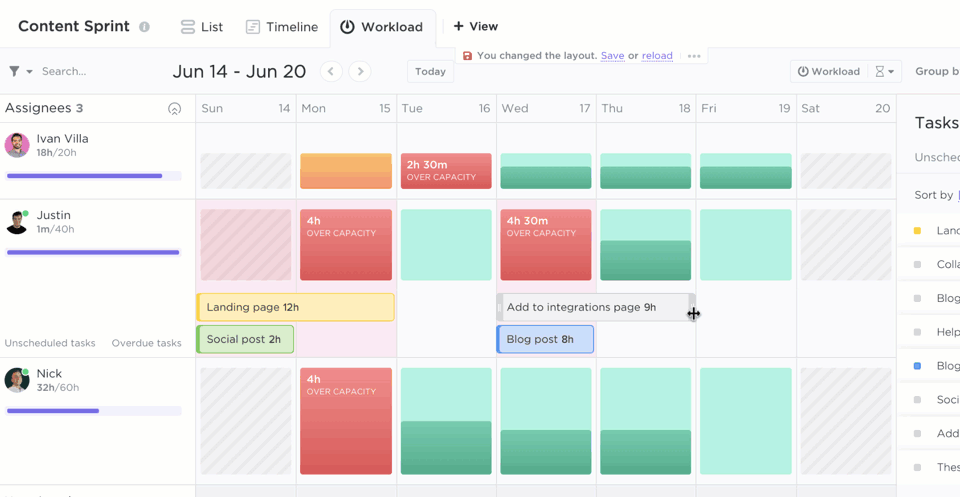
The real work starts once a bug is assigned. Your engineers need to reproduce the issue, trace its origin, and patch it—usually while juggling a dozen other priorities.
AI can make this faster by suggesting likely root causes (based on logs or past incidents) and even drafting a first version of the fix.
Collaboration is equally important. The best teams don’t bury context in emails; they keep notes, screenshots, and repro steps attached to the bug itself. Short video clips or annotated screen recordings often beat a wall of text in reviews, keeping everyone on the same page without endless meetings.
💡 Pro Tip: Remember to link the fix to the original incident so the audit trails survive the release.
🦄 How ClickUp helps:
With ClickUp’s integrations for GitHub and GitLab, every branch, commit, or PR links directly to the bugs reported.

Engineers can record quick ClickUp Clips to demo a repro or walk the team through their patch, and ClickUp Docs sit side by side with Tasks for capturing technical notes or rollback plans.

👀 Did You Know? ClickUp Brain even drafts documentation or code comments for you, so the fix isn’t just applied but also explained for future reference.
Closing a bug isn’t just about merging code. It’s about keeping stakeholders aligned and ensuring the knowledge sticks. Support needs to know what to tell customers, leadership wants assurance that major risks are resolved, and engineering should learn how to prevent similar issues. So, writing retro notes in silos or forgetting to update release notes until the last minute can quickly become a major blocker.
Luckily, AI now makes it possible to generate quick digests, draft customer-facing updates, and even spin out reusable wiki entries from the bug history itself. As a best practice, convert every non-trivial fix into a reusable asset with AI—a runbook, a KB article, or a simple guardrail checklist.
💡 Pro Tip: Set a predictable cadence for communicating updates: real-time alerts work best for critical bugs (P0/P1); a daily digest summarizes the status for active bugs; and a weekly summary can help improve visibility for leadership/support.
🦄 How ClickUp helps:
Pair ClickUp Brain with ClickUp Docs to turn a bug task history into release note drafts or customer-friendly summaries in minutes. Use Relationships in ClickUp to link respective Docs and Tasks to keep knowledge easily discoverable.
A centralized Docs Hub stores runbooks and ensures that fixes live beyond a single sprint.
Weekly updates can be auto-generated via ClickUp’s Prebuilt AI Agents into a centralized Bug Wiki.

Watch this video to learn more about Prebuilt Autopilot Agents!
And because all communication happens inside ClickUp—comments, tasks, or Docs—you’re not scrambling across tools to piece together the story.
🧠 Fun Fact: Want to ship email updates on fixes without leaving your ClickUp Workspace? Get the Email ClickApp and send out emails directly from ClickUp Tasks/comments.
The process doesn’t really end with fixing one bug. Understanding the bigger picture is important, too:
AI analytics make this easier by spotting patterns you might miss: recurring regressions in a specific module, under-resourced teams consistently breaching SLAs, or a rise in reopened tickets.
Hold short retros focused on preventing similar issues. These insights turn bugs from one-off headaches into opportunities for systemic improvement. Turn action items into tracked tasks with owners and due dates.
🦄 How ClickUp helps:
ClickUp Dashboards give you a live view of the metrics that actually impact behavior: MTTR, reopen rates, and SLA breaches broken down by assignee, squad, or priority. You can set up filters and create saved views to spotlight hotspots.
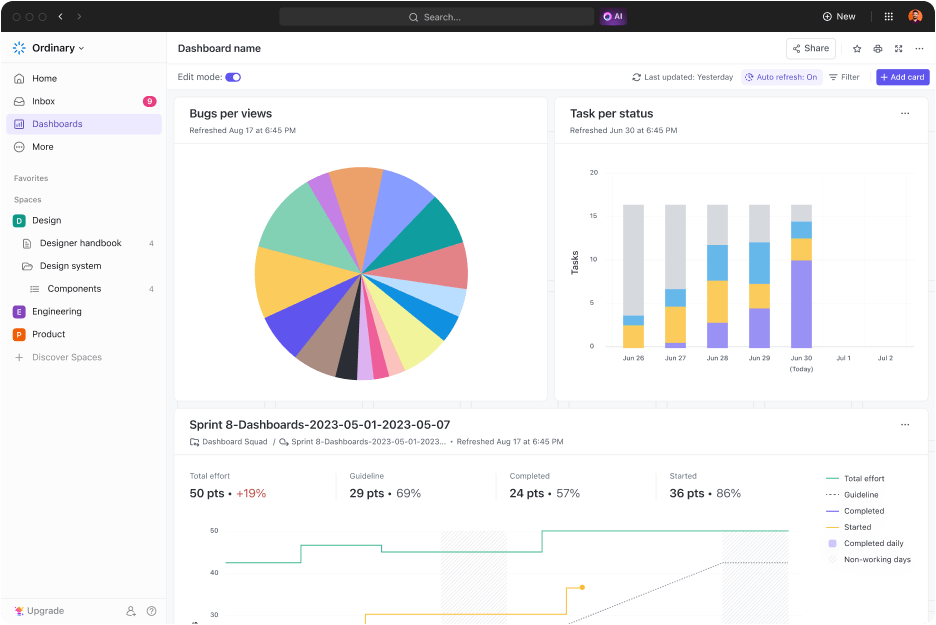
AI Cards within Dashboards can surface hidden trends—like a cluster of bugs tied to a recent feature release—without manually digging in deep into the data.

💡 Pro Tip: Use retrospective templates in ClickUp to convert your learnings into owned follow-ups. They let you set SMART goals for preventive action items, assign ownership, and monitor progress, so insights don’t just stay in slides—they translate into measurable change.
Why this flow works: By following this 5-step process, you’re shrinking time-to-signal (better intake), time-to-decision (scored priority), and time-to-fix (tight execution), while preserving context and turning every incident into institutional memory.
Want to implement the above workflow but feeling daunted by the setup time and effort?
Try these ready-to-use ClickUp templates to get a head start:
If you’re juggling submissions from support, QA, and product teams, and dread switching between tools, the ClickUp Bug & Issue Tracking Template is a game-changer. It bundles everything into one workspace—intake forms for software teams, tracked bug tasks, progress views, and dashboards—so your team can go from report to resolution without leaving ClickUp.
🤝 Ideal for: This is perfect for full-stack teams—product managers, QA leads, and support managers—who want a unified bug-tracking system they can spin up in seconds
When speed and clarity in resolution matter most, the ClickUp Bug Report Template gives you a clean, structured way to capture bugs—complete with a logical flow of details and status tracking baked in.
It helps reduce “What did you do? Where did you see it?” follow-ups so engineers spend time fixing, not chasing context.
🤝 Ideal for: QA engineers, testers, and support agents who need to report bugs precisely and consistently
Sometimes, you’ve already got the bug details, but not in the right format that you need to record them. The ClickUp Bug Task Template gives you a quick, no-frills structure to track one bug end-to-end. It’s lightweight, easy to adopt, and perfect for filling gaps in ad hoc workflows.
🤝 Ideal for: Support reps or engineers who need to log or record issues quickly—especially when time is tight, and clarity can’t wait
Need a more general-purpose template to deal with both bugs and non-technical issues? The ClickUp Issue Tracker Template is perfect for storing and managing all reported issues in a central database.
🤝 Ideal for: Product ops managers, IT leads, and PMs coordinating cross-functional workflows—especially when issues aren’t only technical
When you’re collecting bug feedback—not just from your support team, but also right from customers or beta testers—you don’t want another chaotic survey floating in your “Downloads” folder. The ClickUp Feedback Form Template delivers a structured yet flexible form that ensures you’re capturing feedback consistently, without sacrificing nuance or context.
🤝 Ideal for: Product managers, UX researchers, and support leads who need a simple, effective way to collect and act on user feedback—especially when building an AI-informed bug triage or prioritization workflow
💡 Pro Tip: Instead of manually sifting through form submissions, use ClickUp Brain to:
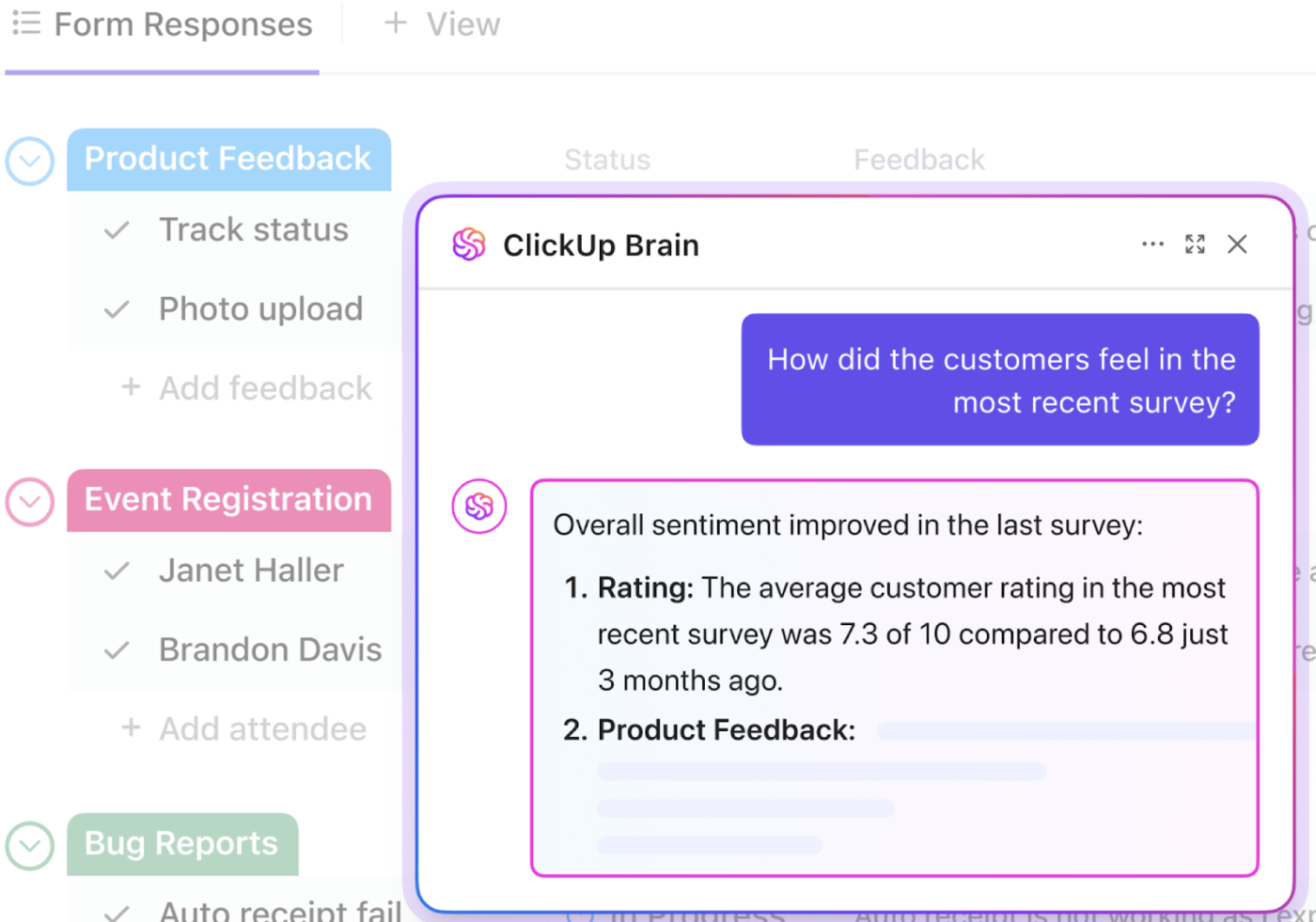
This turns your feedback form into a living insights hub. Say goodbye to exporting spreadsheets and hello to actionable takeaways in seconds.
Now, let’s move beyond theory and see how companies are actually using AI to crack the bug code. In this section, you’ll find real examples and results that matter.
Imagine an AI that doesn’t just follow commands—but thinks like a security expert. That’s the concept behind Big Sleep, a new anomaly hunter created by Google DeepMind and Project Zero. Unlike traditional tools, this system autonomously traverses open-source codebases looking for vulnerabilities that human eyes—and existing automation—could miss.
In its first real-world deployment, it combed through widely used projects like FFmpeg and ImageMagick, uncovering 20 previously unknown vulnerabilities.
Google emphasized that while AI drives detection, human oversight remains essential throughout the evaluation process. With initiatives like these, Google is positioning itself at the forefront of next-gen, proactive cyber defense.
In large-scale software projects, triaging bug reports—assigning them to the right developer—is laborious and error-prone. Bug reports contain free-form text, code snippets, stack traces, and other noisy inputs. Traditional models relying on bag-of-words (BOW) features often miss context and order, leading to suboptimal accuracy.
A team of IBM Research engineers stepped up with a radical solution: DeepTriage. They proposed using an attention-based deep bidirectional recurrent neural network (DBRNN-A) to learn rich, context-aware representations directly from bug titles and descriptions.
DeepTriage leveraged both triaged (fixed) and untriaged (open) bug reports—unlike previous studies, which ignored this ~70% of data—for unsupervised feature learning. After transforming bug reports into dense vector features, various classifiers (softmax, SVM, Naïve Bayes, cosine distance) were trained on this representation to predict the most likely developer.
DBRNN-A outperformed traditional BOW and statistical models—delivering notably higher Rank-10 average accuracy (i.e., developer ranked within the top 10 predictions).
An open-access study in Empirical Software Engineering looked at how ML models help identify invalid or spam bug reports in industrial environments. Having too many invalid reports slows triage and muddies priorities.
Visual and verbal explanation tools—using state-of-the-art ML interpretability frameworks—significantly increased trust compared to opaque predictions. By applying such models tailored to detect invalid submissions early, they significantly trimmed down the noise in the bug queue.
This meant that triage teams spent more time on real, valuable bugs and less on filtering junk.
📚 Also Read: How to Use AI in DevOps
AI is a powerful accelerator, but like any tool, it comes with trade-offs. Here’s what to watch out for while implementing AI in bug tracking and resolution:
AI thrives on structured, detailed bug reports—titles, reproducible steps, severity tags, environment data, and other critical information. But most organizations still deal with inconsistent, incomplete, or even duplicate reports scattered across Slack threads, spreadsheets, and issue trackers. Feed that into an AI system, and the output will be equally unreliable: misclassified bugs, misplaced priorities, and wasted engineering time.
📮ClickUp Insight: 30% of our respondents rely on AI tools for research and information gathering. But is there an AI that helps you find that one lost file at work or that important Slack thread you forgot to save?
Yes! ClickUp’s AI-powered Connected Search can instantly search across all your workspace content, including integrated third-party apps, pulling up insights, resources, and answers. Save up to 5 hours in a week with ClickUp’s advanced search!
AI trained primarily on historical bugs can struggle to detect new classes of failures—especially those caused by emerging tech stacks, unusual integrations, or edge cases never seen before. The risk here is false confidence: AI may categorize a novel critical bug as a low-priority duplicate, delaying fixes and eroding trust.
In fact, experts warn that over-reliance on AI without oversight can backfire. Firms need to knit AI into specific, low-risk areas like issue prioritization—but emphasized that without this careful approach, AI tools can actually hinder developers’ productivity and morale.
While 94% of backend engineers and IT leaders are using AI tools, only 39% have robust internal frameworks to support them. That mismatch leads to systems that falter under scale, erode confidence, or create more technical debt.
Trust is a theme worth pausing on. Engineers and support managers won’t blindly accept AI-driven assignments until the system has consistently proven itself. That “trust gap” means adoption is often slower than vendors promise.
Add to this the hidden costs of implementation—time spent integrating with version control, CI/CD, and monitoring tools—and it becomes clear that AI isn’t a plug-and-play solution.
Many AI systems act like black boxes, spitting out severity labels or fix suggestions without context. Teams want to know why a bug was prioritized or routed to a specific squad. Without transparency, leaders hesitate to base high-stakes release decisions on AI outputs.
📌 In short: AI can speed up what’s already working—but if your process is messy, it risks amplifying the noise. Recognizing these limitations upfront is the difference between a failed rollout and a successful AI-powered workflow.
If AI isn’t a silver bullet, what’s the right way to use it? Consider these best practices:
Start by identifying the narrowest, most painful choke point in your bug process—maybe duplicate reports clogging triage, or hours wasted manually assigning issues. Deploy AI there first. Quick wins create momentum and build trust across engineering, support, and product teams.
🧠 Fun Fact: 92.4% of software organizations found positive SDLC effects after adopting AI. That’s not random. In fact, it reflects smart, focused implementation.
AI learns from what you feed it. Ensure bug reports are consistent, with clearly labelled fields for environment, reproduction steps, and severity.
Standardizing intake dramatically improves AI’s ability to classify and prioritize correctly. Many successful teams create lightweight submission templates or forms that guarantee every report has the essentials before AI touches it.
AI may be best at pattern recognition, but it still doesn’t compare to human judgment. Let it suggest severities, priorities, or even code fixes—but allow engineers to validate them. Over time, as accuracy rates climb, human oversight can scale back. This gradual handoff builds confidence instead of resistance.
You can’t justify AI adoption on gut feelings. Track metrics like MTTR (mean time to resolution), MTTD (mean time to detection), reopen rates, and escaped defects before and after AI rollout. Teams that publish these improvements internally—“triage time dropped from four hours to 20 minutes”—see faster buy-in from leadership and engineers alike.
If you want to avoid the “black box” problem, choose systems that show why a bug was prioritized or linked to a particular root cause.
Deloitte predicts that by 2027, even in conservative estimates, generative AI will be embedded across digital products—even in bug workflows. That means AI needs to align with architecture, culture, and strategy—not just the next quick win.
Let’s peer into the future to see where AI is steering the bug resolution process next.
By 2028, 15% of daily work decisions will be made autonomously by AI agents.
The shift toward agentic AI—autonomous agents that can act, decide, and adapt—is happening fast. Bug triage is a natural target here, with AI soon capable of diagnosing, prioritizing, and even fixing certain classes of bugs—without engineers lifting a finger.
📮 ClickUp Insight: 15% of workers worry automation could threaten parts of their job, but 45% say it would free them to focus on higher-value work. The narrative is shifting—automation isn’t replacing roles, it’s reshaping them for greater impact.
For instance, in a product launch, ClickUp’s AI Agents can automate task assignments and deadline reminders and provide real-time status updates so teams can stop chasing updates and focus on strategy. That’s how project managers become project leaders!
💫 Real Results: Lulu Press saves 1 hour per day, per employee using ClickUp Automations—leading to a 12% increase in work efficiency.
As applications get more complex and release cycles shorten, self-healing and predictive testing are moving from “nice-to-have” to essential infrastructure.
One case study showed QA teams stuck in a frustrating cycle: Brittle test scripts broke with every minor UI update, and engineers burned through 40+ hours each month just to maintain their automated tests. It was expensive, slow, and demoralizing.
Then they introduced an AI/ML-powered self-healing framework. Instead of collapsing every time an element changed, the system adapted in real time—automatically re-identifying locators and updating itself without constant manual intervention.
The impact was dramatic. Monthly maintenance time dropped from ~40 hours to just 12, a 70% reduction. Costs followed suit, with savings estimated at around 60%, and adaptive detection maintained an impressive ~85% success rate in handling changes.
Generative models are already creating test cases and diagnosing failure patterns. A seminal research paper highlights how AI can dynamically generate and adapt tests based on context—boosting regression efficiency and reducing human oversight.
70% of developers don’t think of AI as a threat.
AI is letting engineers spend less time on repetitive debugging and more time on strategic problem-solving and innovation.
Incorporating AI has changed software development for good, dramatically reducing the burden on developers by automating repetitive tasks, streamlining workflows, and freeing developers to focus on creative problem-solving and innovation.
Within just a few years, teams won’t be debating if AI should help. They’ll be deciding which agent should handle logs, which one triages, and which one drafts the fix.
AI will stand not just next to your team, but in front—spotting potholes so you can build smoother roads ahead.
📚 Also Read: Best AI Agents for Coding
The real future of AI in bug tracking and resolution is about foresight, not firefighting. And that’s where ClickUp shines.
ClickUp isn’t just another bug tracker; it’s the everything app for work, bringing intake, triage, execution, retros, and reporting into one platform. With AI built right into your tasks, docs, forms, and dashboards, you’ve got everything you need to resolve bugs faster, learn from them, and keep your team focused on building what matters.
The bottom line: AI helps you squash bugs. ClickUp helps you squash chaos.
AI bug tracking automates detection, categorization, and prioritization of issues using machine learning, while traditional bug tracking relies on manual input and human triage. AI reduces noise, flags duplicates, and accelerates resolution, unlike manual workflows that may be slower and more error-prone.
According to peer-reviewed research and industry testing, modern AI bug-detection models achieve up to 90% accuracy in classification and defect discovery. Accuracy improves with structured bug reports and larger training datasets.
AI prioritizes bugs by analyzing severity, user impact, frequency, and business context. It uses historical data and real-time signals to recommend priority levels, so high-impact issues surface before less critical ones.
Yes, in limited cases. AI tools like Facebook’s Getafix and GitHub Copilot Autofix suggest or generate fixes for recurring bug patterns. In most cases, human engineers still review and validate patches before deployment.
AI can forecast bug-prone areas using historical defect data, code complexity metrics, and testing patterns. Predictive analytics highlight high-risk modules, enabling teams to strengthen tests or refactor code proactively.
Costs vary. Many tools offer free tiers, while enterprise-scale AI solutions can be custom-priced, depending on usage volume, integrations, and advanced analytics needs.
Most AI bug-tracking solutions integrate directly with Jira and GitHub via APIs, apps, or plugins. These integrations allow bug tasks, commits, and pull requests to stay linked, ensuring smoother triage and resolution.
Challenges of AI in debugging include data quality issues, model bias, lack of transparency, and trust gaps. AI can misclassify novel bugs, add hidden implementation costs, or act like a “black box” without explainability.
No, AI bug tracking doesn’t replace QA engineers. AI automates repetitive triage and detection, but QA engineers remain critical for judgment, exploratory testing, and validating fixes. AI augments QA teams, enabling them to focus on strategy, edge cases, and software quality improvements.
© 2025 ClickUp